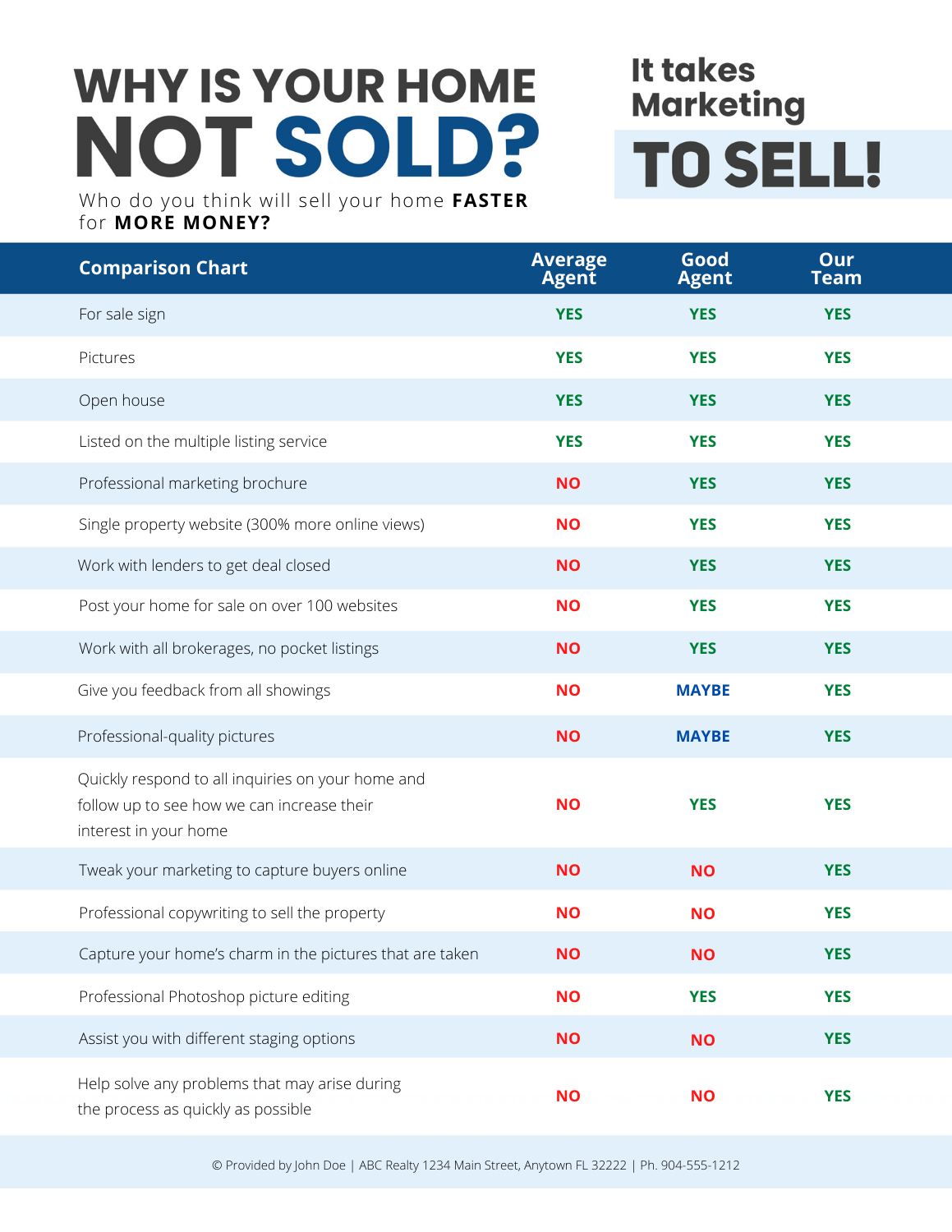Get More Listings With The Instant Trust Package
Welcome to your one-stop-shop for everything you need in order to gain instant credibility with your Instant Trust Package. Below you will find all of the instructions and templates you need to separate yourself from the competition.
In addition to the Instant Trust Package, you have access to The Complete Guide To Finding Leads where we walk you through finding listing leads online in the Top 8 Niches. Not only that, you also will learn how to hire someone on Fiverr.com to gather leads while you close the listing appointments.
The Instant Trust Package
What Is An Instant Trust Package?
Your Instant Trust Package is designed to help create the best possible first impression when reaching out to a new lead.
This package should be mailed to or dropped off to the seller prior to making the first phone call. Sending this package ensures all future phone calls are no longer cold-calls but rather warm-calls

Check out what member Weyland had to say about making contact with home sellers after sending The Instant Trust Package.

You don’t have to add all of these marketing pieces. Modify the documents to match what you do and the way you do business.
**NOTE**
The downloadable templates below will require a free Canva.com account. Be sure to watch the tutorial videos in each of the following sections for instructions on how to customize each template.
If you are new to Canva, please watch the following video to see how to create a free account and set it up for success.
Cover Letter
The cover letter introduces you and explains why you’re sending the book. Linked below are five variations of our General Sellers cover letter.
Click the desired image to access the customizable Canva Template.
Watch the video below for customization tips.
Customization Checklist:
Agent Comparison Chart
Use this chart to compare what you do to market a home versus what kind of service the average agent typically provides.
Click the desired image to access the customizable Canva Template.
Watch the video below for customization tips.
Customization Checklist:
Marketing Plan
Use this sample marketing plan to illustrate what you offer and how you market the homes you list. Feel free to modify this to match what you will do to market your prospect’s home.
Click the desired image to access the customizable Canva Template.
Watch the video below for customization tips.
Customization Checklist:
Reference Letters
Add testimonials and references from customers and colleagues to this document.
Click the desired image to access the customizable Canva Template.
Watch the video below for customization tips.
Customization Checklist:
Photo Brochure
This will prove that you are going to advertise the home better than other agents.
Click the desired image to access the customizable Canva Template.
Watch the video below for customization tips.
Customization Checklist:
The Mailed Package
Insert your book and the package contents inside a bubble mailer. Once you’ve got your books packed up, go to the post office, buy stamps and mail them to your leads.
Where to buy the bubble mailers:

The Drop-Off Package
Simply insert your marketing materials into a clear plastic bag to hang on the leads front door.
How To Find Listing Leads In The Top 8 Niches
Lead generation is everything when it comes to being successful in real estate and we don’t need to tell you that. Ben will walk you through a demonstration for each of the eight niches listed below. You will find tips and tricks for finding qualified leads as well as contact information for the seller.
In the video above, Ben demonstrates the steps to gathering FSBO leads using the follow two methods:
Find the FSBO Listings - using Zillow and other online resources. The most reliable way to find new Fsbos Leads is using Zillow. Simply search using the For Sale By Owner Option. You may also want to search on other sites like Craigslist. But, most Fsbos will be listed on Zillow. However, some home sellers do not even list their home on Zillow.
Instead, they just throw a sign in the yard and hope it sells. That’s why whenever you drive past a FSBO, you want to make a note of the address and check if it’s on Zillow. If not, then you have a great listing lead.
Research the lead’s mailing address.
You can find your leads’ mailing address on your local Property Appraiser or Tax Assessor’s Website. Each municipality will have a slightly different process and in most cases a quick phone call asking for instructions on how to find the information will get the results you are looking for quickly.
How to automate this process. If you’d like to automatically get the new Fsbo Leads everyday, then sign up for a service like Landvoice, The Redx, or Espresso Agent. Their system will automatically send you the new leads every morning. There is a new, free service on the market, Fizbonanza.com that allows you to subscribe to a search area and will send you all the new FSBO leads in your market each Monday.
Insider Tip. The best FSBO Listing Leads are the out-of-town owners. Because they have a hard time showing the house, I have found that they are the easiest to list.In the video above, Ben demonstrates how to gather expired listing leads using the following three steps:
1. Pull the Expired Listings from your MLS.
Once you’re logged into your MLS, look up the Expireds for that day. Usually, you can find them using the Hotsheet or another Listing Search. (If you can’t find them, then contact your Board or MLS and they’ll help you find the info.)
Note: In some areas, you can try to list the Expireds and Withdrawns. In other areas, contacting Withdrawns is frowned upon and can lead to an Ethics Complaint. If you have any concerns about this, talk to your broker.
2. Make sure the property has not been relisted.
You can do that manually by checking their address in the MLS.
3. Research the lead’s mailing address and phone number.
You can find your leads’ mailing address on your local Property Appraiser or Tax Assessor’s Website. Then, look up their phone numbers using one of the websites below.
Whitepages.com- This is a free service that can help you find contact/phone information.
Intelius - This service does have a monthly fee of $20, but it’s great for sourcing cell phone numbers
In the video above Ben demonstrates the steps to finding divorcing homeowner leads in your market.
Note: Depending on your market these records may not be available. In that case, it is best to work with local attorneys to build a divorcing homeowner lead pipeline.
Step A:
Find the divorce records on your local courthouse’s website. Most Divorce Court Cases are filed with your local Courthouse. You can usually find the information with a Google Search.
Try searching “CountyName County StateName Divorce Filing Search.”
Try and search for the records on their website. Some of these sites are a little bit hard to use, and there is a good chance you will need to call their office for help.

Try and search for the records on their website. Some of these sites are a little bit hard to use, and there is a good chance you will need to call their office for help.

Step B:
Check if the divorcing parties own real estate. To do that, cross reference their name with your local property records. You can usually find the property records on your county’s website. It’s usually called the Property Appraiser or Tax Assessor.
Just search for “CountyName County StateName Property Records Search.”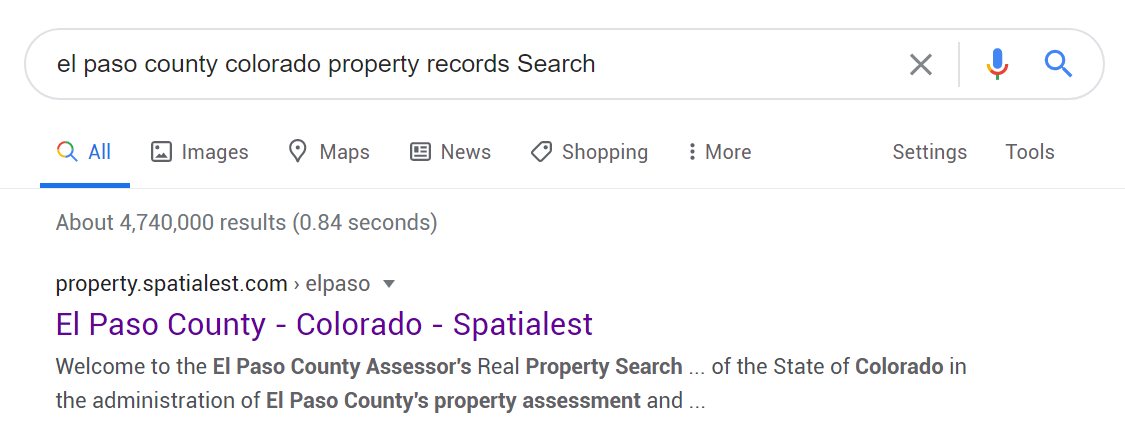
Now, search for the people’s names on the Property Records. In this case, I’m going to look up the Divorce Name from above.

And we have a winner. The Himelick’s own real estate:

Let’s pull up their property:

Now, let’s pull up their property on Zillow and get an idea of what it’s worth:
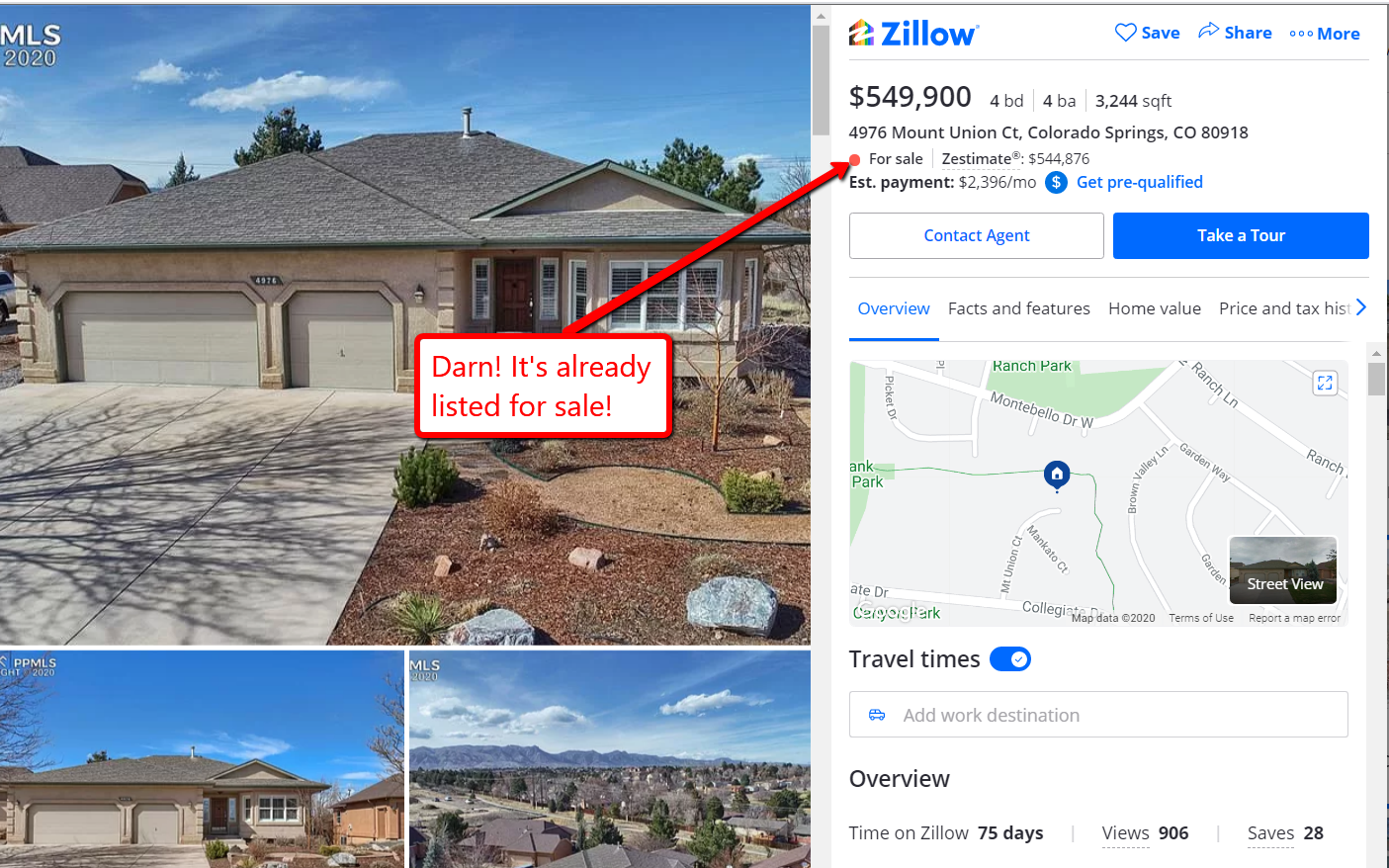
Darn! It’s already listed for sale. I searched about 10 divorce records. Four of them owned real estate, and this was the fourth one I researched. I wanted to show it to you to prove that these people do list their homes!
Step C:
Get the party’s names and mailing address from the property records. You can usually find all the information you need on the property records website.
Step D:
Find their phone numbers. The best way to do that is by simply Googling their name, city, and state. An example is below.
Another option is to search for them using Intelius Premier or WhitePages.com. Intelius Premier is the best because they provide cell phone numbers and don’t try to sell you garbage reports. It costs $20 a month, but you’ll save a lot of time using their service.
Step E:
Organize your leads by adding them to your CRM or organizing them in a Google Sheet. If you use a CRM, then add them in. Or, you can add them to a simple Google Sheet like you see below:
Notes on finding the leads:
It’s not easy to find the divorce filings, but if you’re persistent, you can usually find the information. If you cannot find the divorce filing information, then call your local courthouse and ask them for help.
I recommend calling several times until you find a clerk that will help you. When I was new to the business, some clerks told me that I couldn’t access certain courthouse records.
I didn’t believe them, called back, talked to another clerk, and they helped me find the information.
In the above video Ben demonstrates how you can find inherited home listings, qualify them and find the best contact person.
Getting Started:
When searching for inherited home leads it is important to remember that beyond just locating the listing we want to qualify them in order to make sure we are on the right path.
Find the Probate Court Cases on your local courthouse’s website.
First, you’ll want to find the Probate Court Cases on your local courthouse’s website. Most Court Cases are filed with your local Courthouse. You can usually find the information with a Google Search.
Try searching “CountyName County StateName Probate Case Search.”
Once you find the site, try and find the records on it. Some of these sites are a little bit hard to use, and there is a good chance you will need to call their office for help.
It will take some persistence, but once you figure it out, you’ll be able to find the court cases. If you are not able to find the information on the website, contact the courthouse and have someone help you.
I recommend calling several times until you find a clerk that will help you. When I was new to the business, some clerks told me that I couldn’t access certain courthouse records. I didn’t believe them, called back, talked to another clerk, and they helped me find the information.
Anyways… I managed to find the Probate Court Cases in Duval County.


About 4,450 were filed in 2019.
B. Once you find a lead, you’ll want to do the following to qualify that lead:
Verify that the person who passed away owned real estate.
Check that the person who passed away was the last remaining spouse.
I checked the top probate case and found that the owner did own real estate, and it doesn’t appear she has a spouse on the title.


This lead looks promising! So, let’s continue on to Step #2 and I’ll show you how to find the decision maker and their contact information.
If you absolutely cannot find the Probate Court Records in your area, there are other options for you. I lay out several of them in the last module of this training.
Step 2: Find the best contact person and get their contact information.
You want to find the decision maker who has the authority to sell the house. Usually that’s a Personal Representative, the Executor of the Estate, or an heir.
There are several different ways to do that:
Let’s go through these options one at a time.
How to find the Best Contact Person - using the information in the Probate Court Case Records.
I’ll use this estate as an example. I found the Probate Case using the instructions in Step #1 above.

I clicked and opened the case and found the following information.
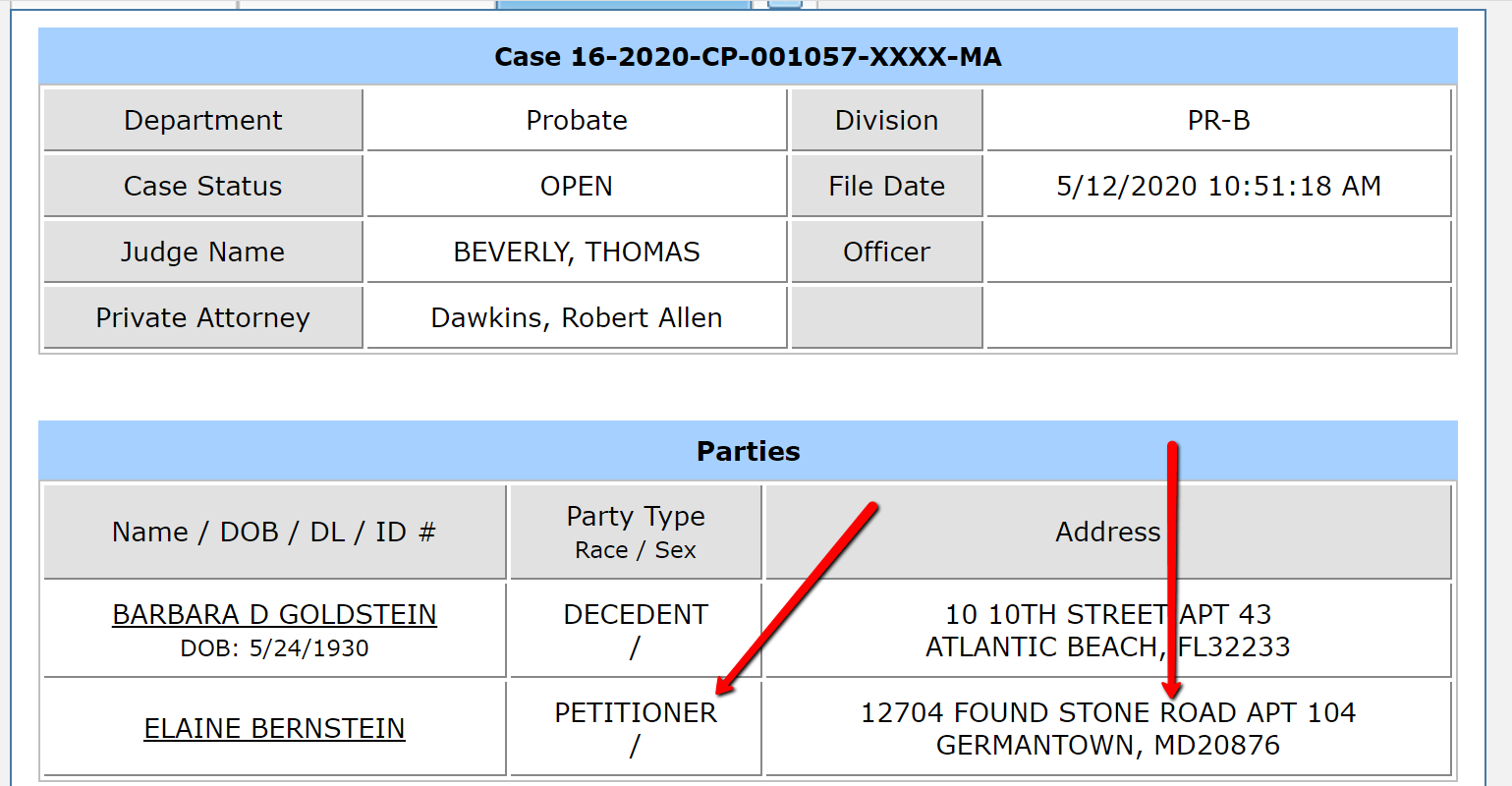
Usually, the Petitioner is the Personal Representative, but I was able to confirm that on this case because I went through the court filings.
I found a Petition for Summary Administration on the Court Docket.

I was able to access the document and found this paragraph on it:

So now that I know I have the right person, how do I find their contact information? I’ll show you how in Step #3.
How to find the Best Contact Person — using the information from the Obituary.
I’ll use this property as an example.

I searched Google and found her obituary. See below.

In the obituary, you’ll want to look for the part that says “survived by” or something like that. Here’s that part of Sarah’s Obituary.

Now that I have their names, I need to find them. You have to be a detective and dig up the information!
First, try to see if their heirs live in the area. You can search local property records or the White Pages or simply google their name and the city. For example, “Susan Staley Jacksonville, FL.”
I found a “Susan Staley” in Orange Park, which is about 40 minutes away, but I couldn’t find any tangible information on her, such as property records, address, or even a phone number.
So I searched for the next daughter and found her. See below.

Notice that she matches all 3 names in the Obituary below?
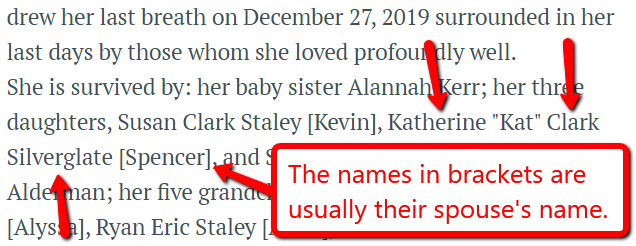
And when I searched for “Katherine and Spencer Silverglate,” this is what I found:

So now that I know I have the right person, how do I find their contact information? I’ll show you how in Step #3. If you’re ready, go there now.
If you can’t find the person using one of those methods, mail your materials to the deceased at their address. One of the heirs is bound to stop by and check the mail.
If you only want to mail the best leads, then drive past the homes and see if anyone is living in them. If a home looks empty, then it’s worth sending them your marketing materials.
I found 2 Inherited Homes about a mile away from our office, so I drove past them this afternoon. One of them was clearly occupied.
But the other had those telltale signs of being prepped to go on the market. Look at the picture below.

I would definitely send them my Instant Trust Package and maybe even leave a note on the door!
In the above video Ben breaks down the various vacant lead sources and demonstrates how to locate them.
You’ll notice that the quality of the vacant leads varies depending on the source. Here are some of the different lead sources, ranked according to their likelihood of selling.
Highest quality leads, most likely to sell:
Evictions. I’m talking about single family or condo evictions where the property owner doesn’t own more than 3 properties. (Apartment evictions don’t count.)
You can find eviction filings at your local courthouse. Call or visit your local courthouse for more information.
High-End Vacant Lots or Vacant Land — where the owner lives out of town. The best leads are people who have owned the property for years and live out of town.
A lot of them simply hold onto the property for years and just never get around to selling it. You’d be surprised how many are open to selling once you contact them.
Get these leads from one of the paid data providers or your local Property Appraiser or Tax Assessor. Contact them for more information on how to get the lists.
Absentee Owners with other signs that the owner may be interested in selling. Here are some of those signs: long grass, unkept yards, broken windows, delinquent property taxes, or anytime the home simply looks vacant.
If you get a list of Absentee Owners from one of the lead providers above, you can find the ones that are most likely to sell by driving past the homes or checking their tax records on the Tax Collector’s Website.
Medium quality leads, likely to sell:
Absentee Owners who live out of town. Some of the lead providers allow you to buy a list of only this type of lead.
Absentee Owners where the owners are over 65 years old. In the National Association of Realtors 2019 Profile of Home Buyers and Sellers, the largest percentage of sellers (24%) are between the ages of 65 and 74. So, when you combine an Absentee Property with an owner that’s 65+, they’re much more likely to want to sell.
You can often find someone’s age just by Googling their name and location. Look at the screenshot below:

An Insider Tip: You can research the age of all the property owners using a Demographic Appender like Data Finder. They will append Phone Numbers for 4 cents per matched record and the person’s age for 4 cents per matched record.
They have a minimum order of $100. If you want a ton of great vacant leads, then buy a list of 5,000 from Melissa Data, Append their info using DataFinder, and then start working those leads.
High-End Vacant Lots or Vacant Land - where the owner lives in the area. They aren’t as likely to sell as the owners who moved away. But a lot of them do want to sell.
I’ve listed a lot of properties like this simply because my contact was the one thing that “pushed them off the fence” and got them to take action.
Absentee Owner Tear-Down Leads. This is where the seller will be more likely to sell because they can get a lot more for their property than what they’re earning in rent.
A perfect example is this property just down the road from our office:

I estimate that each lot is worth about $300,000. So, they could probably sell it for $900,000. And, even if the owner was in town, $900,000 cash is much more attractive than the $1,900 a month they’d get in rent.
For Rent by Owner - where the owner lives out of town. Rentals are so tough. And very few property owners really understand the risks associated with being a landlord, much less how to deal with those risks.
When you show them the risks, and the fact that you can help them get rid of their properties and put money in their pockets, they often decide to sell instead.
You can find rentals on Zillow, Craigslist, and the Facebook Marketplace.
For Rent by Owner - where they’ve been for rent for longer than 30 days. Most rentals rent out pretty fast. But the ones that are on the market for longer than 30 days are highly likely to want to sell.
You can find rentals that have been on the market for a while by sorting for “Newest” on Zillow and scrolling to the oldest rentals. See below:

Below is a rental that’s been on the market for over 60 days. It’s worth about $350,000 and would be a great listing lead.

When you show them the risks, and the fact that you can help them get rid of their properties, and put money in their pocket, they often decide to sell it instead.
Lower quality, less likely to sell leads.
Yes, these people do sell. But they’re not as likely to sell as some of the people I’ve talked about above.
Regular absentee Owners that live in the area and are less than 65 years old.
For Rent by Owner where the owner lives in town.
All Tear-Down Leads. Yes, I know this training is about Vacant Homes. But, you’re going to come across lots of Tear Down Leads. So, you might as well work all of them.
I think it’s worth contacting the Owner Occupants! Some of these properties are such great listings that you don’t need any other selling motivation indicators!
But, if you want to sort out the best leads, look for some of these selling motivation indicators:
In the video above, Ben demonstrates how to gather Delinquent Property Tax Listing Leads using the following three steps:
1. Find the Delinquent Tax Information at your local Tax Collector’s Office. In most areas, the local Tax Collector is put in charge of collecting the property taxes that are due from the public.
Google “County Name Tax Collector” to this information. Every year, their office will publish a list of people who are behind on their property taxes. You can often get a list of everyone who is behind on their property taxes right on their website. If that doesn’t work, then you can visit their office in person to get the list.
If you can’t get the information on their website, then call their office. They have Clerks that can show you exactly how to find the records and walk you thru the research process. I’ve found most of the clerks are helpful.
An insider tip. If one clerk is difficult, then call back and talk to someone else. I have had one clerk tell me “That information is not available. It’s not Public Record.” I knew they were wrong. So, I called back, talked to another clerk, and got the information I needed.
2. Once you have the Delinquent Tax Leads, you’ll want to find the property information. You can usually find that in the property Database Records held by the Property Appraiser or Tax Assessor's Office.
In most cases, you can find the property record by searching using the Tax Parcel Number, Property Owner’s Name, or Legal Description. Once you find the property, make sure that it is the correct property.
You can verify this by cross referencing the Tax Parcel Number or Property Address with the property records. If that doesn’t work, then try cross referencing the legal description with the property records. Once you’re confident you have the correct property, then move onto the next step.
3. Research the lead’s mailing address and phone number. You can find your leads’ mailing address on your local Property Appraiser or Tax Assessor’s Website. Then, look up their phone numbers using one of the websites below.Most Pre-Foreclosure & Short Sale Leads are one and the same. Yes, not all short sales have a foreclosure filing. But, there aren’t that many good ways to find short sale leads, until a foreclosure notice has been filed.
So, if you’re looking for Short Sale Listing Leads, then find the Pre-Foreclosure Leads in your area. Some will have equity and not require a short sale. And, the ones that are upside down are the short sale leads you want.
In the video above, Ben demonstrates how to find pre-foreclosure and short sale leads using the steps below.
1. Find the Foreclosure Filings at your local county courthouse. In most places, a document is filed in the Public Records. This document is either called a Lis Pendens or a Notice of Default. Most of these documents will have the property owner’s name and the property legal description.
You can usually find the website to research this by Googling “County Name Public Records”, “County Name Official Records”, or “County Name Courthouse.” Sometimes Google will lead you to the exact spot to get the information.
Note. If you can’t find the information on the Courthouse Website, then call the courthouse. They have Clerks that can show you exactly how to find the records and walk you through the research process. I’ve found most of the clerks are helpful.
An insider tip. If one clerk is difficult, then call back and talk to someone else. I have had one clerk tell me “That information is not available. It’s not Public Record.” I knew they were wrong. So, I called back, talked to another clerk, and got the information I needed.
2. Once you have the information from the Foreclosure Filing, you’ll want to find the property information. You can usually find that in the property Database Records held by the Property Appraiser or Tax Assessor's Office.
In most cases, you can find the property record by searching using the owner’s name. If that doesn’t work, then try using the legal description. Just be warned that it can be difficult.
Once you find the property, make sure the legal description on the foreclosure filing matches the legal description on the property records. Once you’re confident you have the correct property, then move onto the next step.
3. Research the lead’s mailing address and phone number. You can find your leads’ mailing address on your local Property Appraiser or Tax Assessor’s Website. Then, look up their phone numbers using one of the websites below.In the video above, Ben demonstrates how to gather eviction listing leads using the following three steps:
1. Find the Eviction Filings at your local county courthouse. In most places, an eviction is handled as a Court Case. And, these Court Cases are public information. You may not be able to access every document, but you can get the general information.
You’ll usually find the Court Records on your local Courthouse Website. You can usually find this information by Googling “County Name Court Records Search.” Sometimes Google will lead you to the exact spot to get the information. If that doesn’t work, then search for “County Name Courthouse Court Records Search.”
Note. If you can’t find the information on the Courthouse Website, then call the courthouse. They have Clerks that can show you exactly how to find the records and walk you thru the research process. I’ve found most of the clerks are helpful.
An insider tip. If one clerk is difficult, then call back and talk to someone else. I have had one clerk tell me “That information is not available. It’s not Public Record.” I knew they were wrong. So, I called back, talked to another clerk, and got the information I needed.
2. Once you have the information from the Eviction Filing, you’ll want to find the property information. You can usually find that in the property Database Records held by the Property Appraiser or Tax Assessor's Office.
In most cases, you can find the property record by searching using the Plaintiff’s Name. (The “Plaintiff” is the person filing the Eviction Case to evict the tenant. Once you find the property, make sure that it is the correct person.
You can verify this by cross referencing the Plaintiff’s Address with the property records. If that doesn’t work, then try cross referencing the legal description with the property records. Once you’re confident you have the correct property, then move onto the next step.
Focus on the small time landlords. If a landlord owns a quadraplex or more than 4 individual units, then they are probably comfortable with an eviction from time to time.
3. Research the lead’s mailing address and phone number. You can find your leads’ mailing address on your local Property Appraiser or Tax Assessor’s Website. Then, look up their phone numbers using one of the websites below.Using Fiverr To Generate Leads
Leads are the name of the game in any form of sales, real estate included. Lead generation can be a time-consuming process, and wouldn’t you rather be out converting leads rather than spending hours locating them?
In the video above, we show you how to contract out the task of lead generation for as little as $5 using freelancers via Fiverr.com.Go to Fiverr.com and select the Join button located in the top right corner.

A pop-up box will appear, giving you multiple sign-up options.

You will now be prompted to create your Username and verify Email Address.

From the Fiverr home page, you will see the Find Services Search Box.
Enter Real Estate Leads and click search.
Once your initial results are populated, you can refine the search to better fit your needs. There are several customizable options to choose from.
First, click the Category dropdown menu and select Lead Generation.
Next, click the Service Options dropdown menu.
Select the Real Estate option.
The third tool you can use to refine your search is Seller Details. This allows you to select the level of experience/trust in the seller.
From the dropdown menu, select Level Two Seller. This will give you high-quality results.
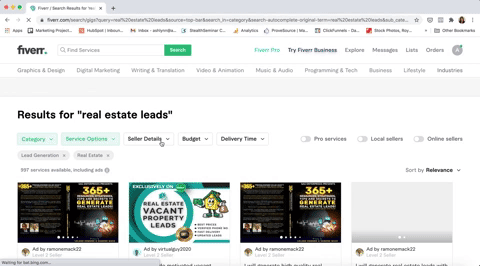
Next, you can select the Budget.
Click the dropdown menu and enter a minimum and maximum value.
We suggest setting the values from $5-$20.

As your search becomes more refined, you will be able to browse the list of sellers.
You will see a brief description, number of reviews and starting listing price from this preview view.

As you click on the individual sellers, you will open their listings.
Scroll down the page to see everything the seller offers. In our example, you will see multiple niche-specific leads are available.
You will also see the delivery time of the leads.

Each Fiverr seller will have multiple levels of service. On the right-hand side of the page, you will see options for Basic, Standard and Premium levels of service.
Once you have chosen the desired level of service, click the Continue button.
Now you are ready to make your purchase.
Click the Continue To Checkout button and fill out the payment information.
Once the order has been placed, you will see a button that says Submit Requirements

On the following page, you will want to fill out each section with the listings information for your area.
Question 1 - What type of list? Here are some common lists requested:
-Absentee
-Vacant
-Expired
-High Equity
-Tax Delinquent
-Liens (Tax, HOA, Utility, Etc.)
-Pre-Foreclosures
-Foreclosures
-Failed Listings
-Inner-Family Transfer
-Divorce
Question 2 - Location? You can use Zip Codes or City Name.
Question 3 - Additional Info - This section is optional, but it allows you to add any filters or list preferences you’d like the freelancer to be aware of.
Once you’ve finished adding your information, select the checkbox and Press the Start Order button.
Each Fiverr seller will have a different delivery time. Once your order is ready, you will receive an email.
You can also view the status of your order by clicking on the Orders button at the top right of the page.
Once your list of leads is ready, you can access it using the Delivery tab of the Orders page.
You can then download the document directly to your device.

Now, you have your list of leads.
Simply open it in a spreadsheet software such as Excel or Google Sheets.

Uplevel Your Listing Presentation

Your listing presentation is crucial! It takes a lot of time, energy, and effort to secure a listing appointment. So, it pays off big to make sure your presentation is solid, so you win the listing!
This listing presentation based on hundreds of different listing presentations. We’ve tested out lots of different presentations and strategies. And this one worked the best. We’ve tested it on dozens of different presentations and made little tweaks to perfect it.
Follow the steps below to learn how to customize and deliver the Easy-Close Listing Presentation!
Using a Free Canva.com account, you can quickly and easily customize our 46-page Easy Close Listing Presentation to fit your needs.
Linked below are six templates in total. You will see one fully customizable template that will allow you to add your brand colors and five templates with locked background colors. Be sure to check out the video tutorials below for Canva editing tips and a full roll-play of the presentation.
Not interested in using Canva? Download one of these options instead.
Before you start modifying your presentation, we recommend that you go through the entire presentation to familiarize yourself with it.
Sample Listing Presentation. In this Video, Charles walks you through the presentation as though you were a seller. Other members have found it helpful.
The Easy-Close Listing Presentation template has been designed to require minimal modifications. Simply add your headshot and logo to the first slide. Beyond that, the only other required modification comes on slides 44 and 45. Replace the placeholder testimonials with your own and you are all set.
With that being said, the templates are completely customizable, so you can add your own listing photos and case studies throughout.
Check on the video below for a quick editing tutorial.












